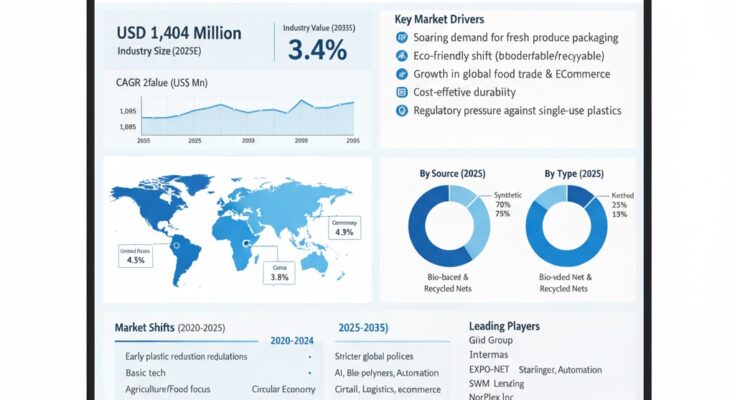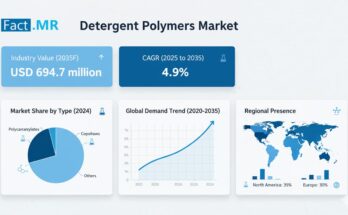The global packaging nets market is poised for steady growth, fueled by the increasing demand for lightweight, cost-effective, and eco-friendly packaging across the food and agriculture industries. According to a recent report by Fact.MR, the market is projected to expand from USD 975 million in 2024 to USD 1,404 million by 2035, registering a CAGR of 3.4% during the forecast period (2025–2035).
As the global food supply chain becomes more sustainability-focused, packaging nets—known for their breathability, durability, and recyclability—are gaining prominence in fruit, vegetable, seafood, and industrial applications. Their versatility and low material usage make them a preferred alternative to rigid and non-recyclable packaging formats.
Strategic Market Drivers
- Rising Demand in Food and Agriculture Packaging
The agriculture and food packaging sectors are key growth engines for the packaging nets market. Increasing global consumption of fresh produce, seafood, and nuts has driven the need for packaging that ensures ventilation, visibility, and product protection during transportation and retail display.
Packaging nets—especially made from polyethylene (PE) and polypropylene (PP)—enable extended shelf life and enhanced visual appeal while reducing plastic weight, aligning with circular economy principles.
- Sustainability and Lightweighting Trends
Sustainability is a major driving force behind market expansion. Manufacturers are developing biodegradable and recyclable netting materials to comply with evolving environmental regulations and consumer preferences. The lightweight nature of net packaging also helps reduce carbon footprint during logistics, promoting greater adoption among eco-conscious brands.
- Expanding Applications Beyond Food
While fruits and vegetables dominate net packaging usage, adoption is growing across other sectors such as shellfish, firewood, industrial parts, toys, and sports goods. The strength, flexibility, and cost efficiency of packaging nets make them suitable for bundling and protection applications across diverse industries.
Browse Full Report: https://www.factmr.com/report/977/packaging-nets-market
Regional Growth Highlights
Europe: Sustainability-Driven Leadership
Europe remains at the forefront of the packaging nets market, with countries like Spain, France, and Italy leading production and consumption. Strict EU packaging waste directives and the transition toward a circular economy are encouraging the development of recyclable and bio-based net materials, particularly for agricultural packaging.
North America: Rising Fresh Produce Consumption
In the U.S. and Canada, increasing demand for fresh fruits and vegetables, combined with expanding retail and online grocery sectors, is fostering market growth. Key players are investing in automation and material optimization technologies to enhance packaging efficiency and reduce waste.
East Asia: Emerging Manufacturing Hub
East Asia is expected to witness strong growth, driven by rising export-oriented agriculture, especially in China, Japan, and South Korea. The region’s robust manufacturing base, coupled with increasing sustainability awareness, is promoting innovation in cost-effective and eco-friendly net packaging.
Latin America & Middle East: Rapid Agricultural Expansion
Growing agricultural exports, especially of citrus fruits, avocados, and onions, are boosting demand for packaging nets in Brazil, Mexico, and GCC countries. Government initiatives supporting sustainable packaging are likely to enhance market penetration over the coming decade.
Challenges and Market Considerations
Despite positive growth trends, the packaging nets market faces several challenges:
- Fluctuating Polymer Prices: Volatility in PE and PP raw material prices can impact production costs.
- Environmental Regulations: Tightening bans on single-use plastics require innovation in biodegradable net materials.
- Competition from Alternative Packaging: Paper-based and flexible film packaging offer cost-effective and customizable alternatives.
- Recycling Infrastructure Gaps: Limited recycling facilities for mixed polymer materials pose challenges to achieving full circularity.
Competitive Landscape
The global packaging nets market is moderately consolidated, with leading manufacturers focusing on sustainability, automation, and material innovation to strengthen their market presence.
Prominent Companies Include:
- SWM (Schweitzer-Mauduit International, Inc.)
- EXPO-NET Danmark A/S
- Giró Group
- GSH Group
- Intermas
These players are emphasizing eco-design principles, expanding production capacities, and forming partnerships with agricultural producers and food packaging companies to deliver next-generation netting solutions.
Recent Developments
- February 2024 – EXPO-NET Danmark A/S opened a low-carbon central warehouse at its Hjørring facility, spanning 3,300 square meters. The energy-efficient site integrates renewable energy and advanced insulation systems, streamlining storage operations while minimizing emissions. The project enhances EXPO-NET’s manufacturing capabilities and supports local employment.
- May 2024 – Giró Group continued to lead in sustainable net packaging solutions for the fruit and vegetable sector, launching lightweight, strong, and breathable packaging options. With a focus on plastic-free and optimized plastic alternatives, Giró’s innovations set new standards in eco-friendly and high-performance packaging.
Future Outlook: Toward a Circular and Smart Packaging Era
Over the next decade, the packaging nets market will evolve toward greater material circularity, digital traceability, and automation. Innovations such as bio-based polymers, smart netting systems for product identification, and AI-driven sorting technologies will define the next wave of growth.
As the demand for sustainable and efficient packaging accelerates globally, packaging nets will continue to play a vital role in bridging functionality, sustainability, and cost-efficiency offering a smart, lightweight, and environmentally responsible solution for the future of global packaging.



